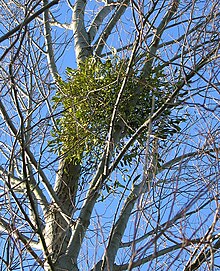Semi-parasites
Semi-parasites (also semi-parasites or hemiparasites ; Greek hemi = half) are parasitic flowering plants ( phytoparasites ) that remove water and nutrient salts from their host plants with the help of special suction organs ( haustoria ) . Unlike the full parasites (holoparasites; Greek holos = whole), they are able to photosynthesize through the possession of chlorophyll and can process the substances taken from their hosts into organic carbon compounds themselves . In some cases, however, they also obtain their nutrients heterotrophically . Mistletoe , for example, is only connected to its host's xylem .
In addition to optional semi-parasites , which can also reproduce without host plants, there are obligatory hemiparasites that are absolutely dependent on the connection to host plants for flower and fruit formation.
In contrast to full parasites, semi-parasites are usually not very host-specific. The hemiparasites among the summer root plants, for example, parasitize, sometimes even simultaneously, on host species from different plant families ( rose plants , legumes , lip flower plants , daisy plants , sour grasses or sweet grasses ). Other plants, such as orchids , on the other hand, are strictly avoided. Self-parasitism also occurs.
The effects of semi-parasites on the plants that grow with them are not necessarily negative. Studies in nutrient- poor, sub- arctic plant communities have shown that semi-parasites have higher nitrogen contents in their leaves than dwarf shrubs , grasses and herbaceous plants . This accelerates the breakdown of the leaf litter and the nutrient cycle.
Examples of semi-parasites in the Central European flora are mistletoe , lice weed , quail wheat and the large rattling pot .
Web links
Individual evidence
- ↑ Hans Christian Weber: About host plants and parasitism of some Central European Rhinanthoideae (Scrophulariaceae) . In: Plant Systematics and Evolution 125 (1976), pp. 97-107, doi : 10.1007 / BF00986775 .
- Jump up ↑ Lytton J. Musselmann & William F. Mann Jr .: Host plants of some Rhinanthoideae (Scrophulariaceae) of eastern North America. In: Plant Systematics and Evolution 127 (1977), pp. 45-53, doi : 10.1007 / BF00988018 .
- ↑ Malcolm C. Press: Dracula or Robin Hood? A functional role for root hemiparasites in nutrient poor ecosystems . In: Oikos 82 (1998), pp. 609-611, ISSN 1600-0706 .
- ↑ Helen M. Quested, Malcolm C. Press, Terry V. Callaghan & Hans J. Cornelissen: The hemiparasitic angiosperm Bartsia alpina has the potential to accelerate decomposition in sub-arctic communities . In: Oecologia 130 (2002), pp. 88-95 ( doi: 10.1007 / s004420100780 ).
